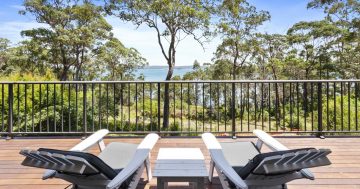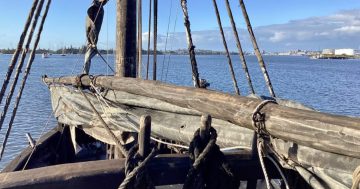
Alastair Greig’s book traces the sale of land from the late 1800s in what is now the Long Beach area. Photo: Sallyann Ducker.
Like many historians, Alastair Greig was looking through some historical documents to find out what had happened in the past.
He had been asked to write a series of short posts for the Long Beach Community Association about the area’s history – but then something caught his eye.
“One little artefact really fascinated me: an 1841 real estate advert for subdivisions on the north side of Batemans Bay,” he said.
“This surprised me, because Batemans Bay itself was surveyed and sold by the government in 1859.
“That was the beginning of Batemans Bay, but here is a private town being sold in 1841.”
In an attempt to solve the mystery of St Vincent, the Emeritus Fellow at the Australian National University (ANU) turned to the NSW Archives and records collected by the Long Beach community.
His research became the basis of The Road to Batemans Bay / Speculating on the South Coast During the 1840s Depression, published through ANU Press in late 2023.
“I slowly began to get a sense that there were stories to be told – not about Batemans Bay as a whole, but simply Long Beach,” he said.
“It was a history that hadn’t been written.
“This was all at the beginning of COVID, so I had a fair bit of time!”
At first it seemed there wouldn’t be much information for him to go on.
“Most historians do mention this private town of St Vincent, but no one seems to know anything about it,” Mr Greig said.
“It’s just one sentence and then they go on.
“But I was fascinated because it was quite clear to me that this town being surveyed and sold in 1841 was actually Long Beach.”
He started by looking at parish maps, and also studied land titles to see who owned the land at different times and read memoirs and insolvency records.
“I discovered that these sales were happening right at the time when Australia was having its first land boom,” he said.
“This is the first time that people began to take for granted that buying and selling land is a way to build wealth in the colony.”
While initial interest in the town was strong, The Road to Batemans Bay tells of other locations competing against St Vincent as a southern port in the colony and, eventually, the bust of land speculation in the late 1800s.
“The book just emerged, because I kept on finding so many connections between the main characters – there were merchants, auctioneers, surveyors, judges and sheriffs,” he said.
“The surprising thing was I started off thinking I was writing a local history, but I actually ended up drawing a picture of the colony, from the perspective of one isolated area, which wasn’t inhabited by any settlers whatsoever.”
The South Coast of NSW is nothing new to Mr Greig – his connection to it goes back decades.
“I’m the same as any Canberra lad,” he said.
“I came over from Scotland as a teenager and one of the greatest joys was going down from the coast with your friends.”
Mr Greig said that through visiting or living in the area over a long period meant he could see how the region had changed over time.
“We do take for granted that the way the land is is the way it’s always been – but it could have been different,” he said.
“It’s always interesting to ask these questions, about why places are isolated and why places became nodes and cities.”
The Road to Batemans Bay will be launched on 19 February at ANU in Canberra, and is available through ANU Press.













